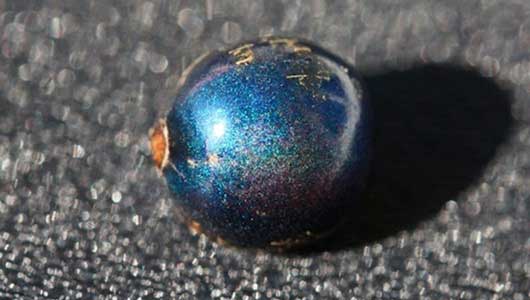
Pollia condensata, colloquially called the marble berry, is a perennial herb with stoloniferous stems and shiny, metallic blue berries found in forested regions of Africa. The berries are of particular interest, as their blue coloration is the most intense of any known biological material.The coloration is a result of the effects of Bragg reflectioncaused by helicoidally stacked cellulose microfibrils. Variations in thickness of the stacks causes the fruit to appear somewhat pixelated.
Taxonomy
 The fruits have a special microscopic structure which allows them to reflect the light. The surface of the Pollia comprises four layers of thick-walled cells forming a quartet of very thick walls, each of these layers consisting of a fibrous variety of other cells.These fibers are aligned with each other, parallel in each layer, which in turn is aligned relatively to the other parts. This causes one to have a vision of a "spiral" when facing the fruit of a top-down perspective.
The fruits have a special microscopic structure which allows them to reflect the light. The surface of the Pollia comprises four layers of thick-walled cells forming a quartet of very thick walls, each of these layers consisting of a fibrous variety of other cells.These fibers are aligned with each other, parallel in each layer, which in turn is aligned relatively to the other parts. This causes one to have a vision of a "spiral" when facing the fruit of a top-down perspective.
Such a complex structural arrangement makes light to be absorbed when it comes into contact with the surfaces of the fruit, and somehow amplified before being reflected back. Physically, this process is called "constructive interference",and the result is a berry that is brighter than any other living existing organism. Despite having no nutritional value, birds are attracted to the appearance of the berries. They will sometimes decorate their nest with them, helping to spread the seeds in the process.
According to Ullrich Steiner of Cambridge University, who co-authored the PNAS paper, "Structural colors come about not by pigments that absorb light, but the way transparent material is arranged on the surface of a substance... This fruit is one of the first known examples in plants. We compared it with some other structural colors, such as the morpho butterfly wing, which is often described as the strongest structural color. This is stronger."Images (by Vignolini et al./PNAS) may be seen alongside the interview, and at various other news sources reporting the PNAS paper findings.